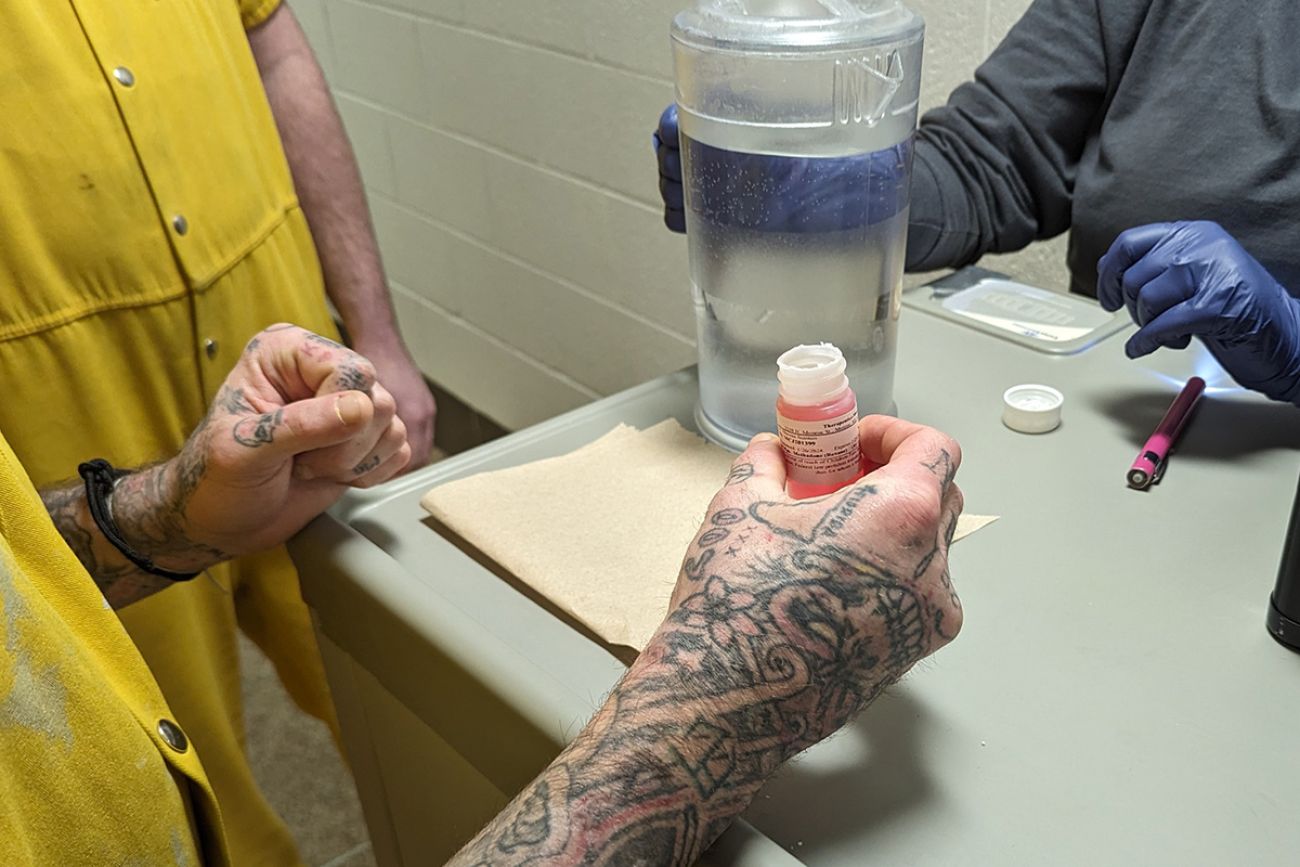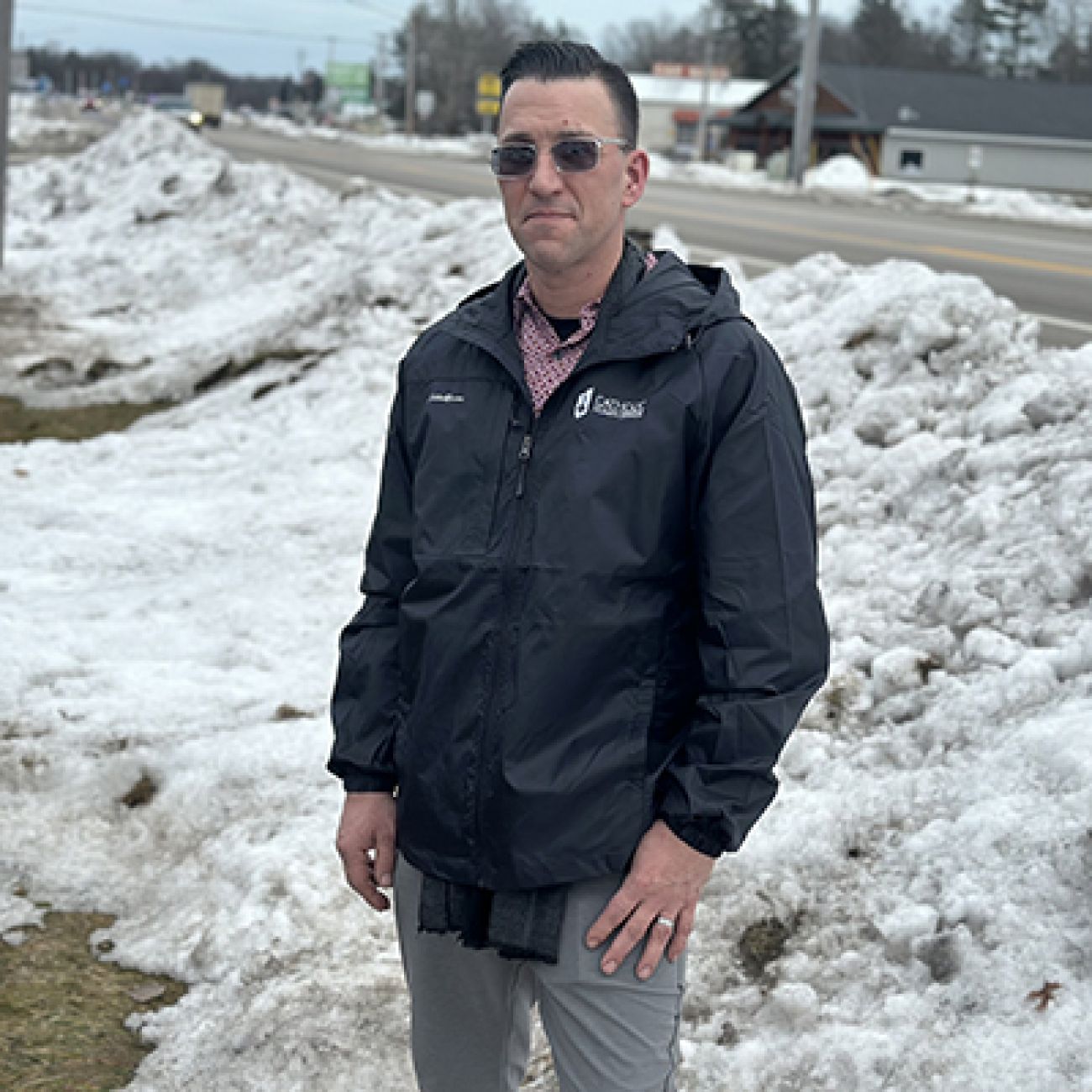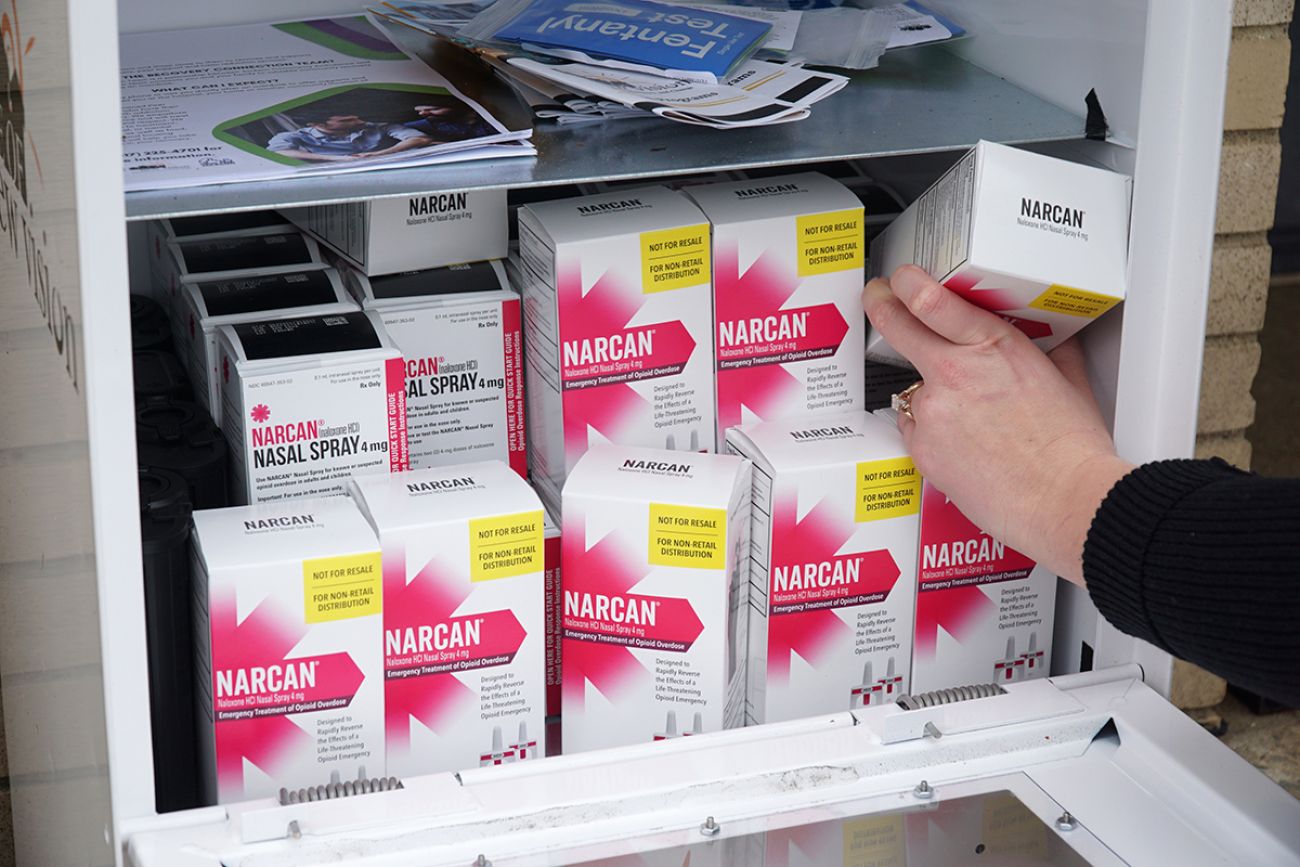As opioid deaths mount, Michigan governments sit on millions for intervention

- Michigan will receive $1.5 billion from an opioids lawsuit settlement to help an epidemic that has killed 11K residents since 2018
- Money began flowing into local governments last year, but many have yet to spend it
- Michigan’s system is ‘a mess’ and its transparency is awful, one expert says
TAWAS CITY — Zach Williams knows he’s lucky to be alive. He was an opioid addict in northeast Michigan for 22 years, and “more of the people I used with are dead than are still alive.”
Sober five years, the 44-year-old peer recovery coach in Iosco County for Up North Prevention and Catholic Human Services lately has attended another wave of funerals. He was a friend of three of six county residents to die in 2023 from overdoses.

Known for its vacation beach cabins dotting Lake Huron, Iosco County is among the many counties in northern Michigan with a drug problem. It’s far above the state average in fatal and nonfatal overdoses and opioid prescriptions, and is in the top quarter of Michigan counties in a substance abuse vulnerability index created by the state’s health department.
Despite having $269,000 earmarked to address the opioid epidemic in the county government’s bank account for nearly a year, officials have yet to spend a nickel.
Related:
- Michigan unveils spending on $1.5B opioid settlement, amid secrecy fears
- Michigan disbands racial equity group as tension mounts over opioid money
- In Michigan, naloxone has reversed over 6,600 overdoses since 2020
- ‘Staggering’ rise in overdoses, suicides for African Americans in Michigan
“The problems are going to continue to grow,” said a frustrated Williams. “People are dying because they haven’t opened the purse strings.”
They’re also dying throughout Michigan, despite an influx of more than $100 million in 2023 alone from a national settlement with opioid manufacturers and distributors. The money is intended to address the epidemic, but thus far remains largely unused as officials struggle to figure out how to spend it.
Iosco County, which has 25,000 residents, eventually will receive $2.1 million, the seventh-most money per capita among Michigan’s 83 counties. Overall, Michigan is expected to get $1.5 billion over 18 years, and has already received $181 million to address a crisis that has killed more than 11,000 Michiganders since 2018.
Making the most of the unparalleled windfall is critical to lessening the crushing toll of opioids. Compared to other states, though, Michigan provides little guidance on how to spend the money to local governments, which will receive about $725 million or nearly half the settlement total. Nor is the state tracking how localities spend the money.
Some officials acknowledge they have little idea what to do.
“It’s too much just to buy (overdose reversal drug) Narcan boxes, but not enough for a treatment center,” said Crawford County Administrator Paul Compo.
About these stories
Michigan is set to receive $1.5 billion from a national settlement with opioid manufacturers and distributors. Bridge Michigan interviewed more than four dozen experts, community leaders and researchers. Many expressed worries that Michigan has not set up enough oversight of how the money is being spent.
See how much your Michigan community will get in opioid settlement funds
Michigan won’t know how $725M is spent on opioid help. Other states do it better
Michigan opioid cash sparks feeding frenzy of vendors, seeking cut of $1.5B
Michigan county ‘hit ground running’ with opioid plan. Then came the complaints
Has the opioid crisis hit your family? We seek Michigan stories
Bridge Lunch Break
On Feb. 28, Bridge reporters and experts will discuss the drug crisis and how Michigan governments are spending the $1.5 billion coming the state’s way. Learn how to sign up here.
Get help
For help with opioid abuse, call the SAMSHA National Hotline, a 24-hour, 365-day-a-year, treatment referral hotline. 1-800-662-HELP (4357)
“I’m waiting for somebody smarter to give us a good idea” on how to spend the money.
Sara Whaley, program director of the Bloomberg Overdose Prevention Initiative at Johns Hopkins Bloomberg School of Public Health, said she worries about Michigan officials’ lack of urgency.
“People are dying, and the reason for these lawsuits was the immense loss of life from this crisis,” Whaley said. “It would be a disservice to the lives lost if this money isn’t used to save future lives.”
Overdoses killed nearly 3,000 Michigan residents in 2022, more than the number of those killed by car crashes or guns combined. Opioids were the cause of 80% of those deaths, with a Michigander dying of an overdose every four hours.
Statewide overdose tallies are not yet available for 2023, when counties first received settlement funds. According to data provided to Bridge by Iosco Medical Examiner William Morrone, half of Iosco’s overdose deaths last year involved fentanyl, an inexpensive, synthetic drug that Morrone said is now the opioid of choice among addicts and the leading overdose killer in the state.
Morrone, who is also the medical examiner in Bay, Arenac and Tuscola counties, shared data showing that 26 people died of overdoses in Bay last year, and 32 died in the first six months of 2023 in Saginaw County.
Some of those deaths could have been avoided, Morrone asserted, if opioid settlement funds had been distributed faster.
“People in treatment and addiction are looking at this money and saying, ‘Where is it? It’s in the bank and the counties won’t let us have it,’” Morrone said.
While some counties that have spent the money have invested in prevention and treatment, the settlement funds also have bought law enforcement equipment such as $200,000 body scanners that detect hidden drugs of jail inmates in Kalamazoo and St. Clair counties.
“It's not hard to spend that money,” said Jonathan Stoltman, director of the Michigan-based Opioid Policy Institute, a national research think tank based in Grand Rapids. “It's hard to spend it well.
“Michigan is uniquely a mess,” he said.
‘Don’t want to waste it’
Over the past month, Bridge Michigan spoke to more than four dozen people involved in opioid settlement fund distribution, from community activists and drug treatment workers, to county and state officials, to national researchers focused on recommending and tracking how settlement funds are being spent. Most acknowledge that Michigan, like many states, has been slow to make use of the potentially life-saving funds. Many said they hope that extra planning time will lead to efficient spending.
In the meantime, county officials say they are barraged with competing priorities from local treatment organizations and for-profit vendors pushing everything from drug tracking software to $260 plastic boxes billed as perfect storage for Narcan (no supplies included).

Nationally, some local governments have used opioid settlement funds for purchases that aren’t directly tied to opioid remediation, like new police cars.
Whether those types of purchases have been made in Michigan is hard to say, because there is no statewide accounting of how the money is spent.
“We are not mental health experts and certainly not drug prevention experts, and we need more guidance on what we can do,” said Compo, the Crawford County administrator. “We don’t want to waste it.”
Michigan’s state government gets a little over half of the settlement funds and has vowed to publicly report how it spends the money on its settlement website. Launched in October, the site lists details about $36.4 million in spending, about a third of the $113.7 million the state has received so far.
But the rest goes to local governments, and advocates say there are so few reporting requirements the public may never know how hundreds of millions of dollars are spent.
Kara Steinke, chief operations officer of Up North Prevention, part of Catholic Human Services, which works in 21 counties in the northern Lower Peninsula, said any criticisms of settlement fund efforts should be leveled at the state, not local officials.
“Michigan didn't set it up right, so there's not a whole lot of accountability,” Steinke said. “If they don't use it the right way, no one's checking. So we're relying on really good people, which I think we have and most of our colleagues want, to do the right thing.”
Steep learning curve
The Michigan funds are part of a national settlement of numerous lawsuits against manufacturers, distributors and pharmacies that were accused of downplaying the risks and ignoring the perils of prescription painkillers, fueling today’s opioid crisis.
So far, the state of Michigan has received $113.7 million, with about two-thirds of the money disbursed to agencies that are coordinating distribution to drug efforts around Michigan.
Meanwhile, local governments have so far received settlement checks totaling $67.7 million. Counties, cities and townships are required to spend 70% of their settlement funds on future opioid remediation; 15% can be used as reimbursement for past expenses in the drug crisis, and 15% can be used for anything those local officials choose.
Some counties, such as Jackson County, have handed the money to the health department. Most, though, are still holding meetings to decide how best to use what will eventually total $725 million divided among 280 jurisdictions.
“It’s been a challenge deciphering exactly what we can spend the money on,” said Tim Dolehanty, administrator of Ogemaw County, where about $400,000 received so far from the settlement is sitting in a bank.
Similarly, Clinton Township in Macomb County hasn’t spent any of the “about half a million” it received, said township Deputy Supervisor Dan O’Leary.
“Potholes, water rates, sewer rates — those are the things that tend to occupy our minds. So don’t be surprised if our final solutions involve partnering with people who are experts in this,” O’Leary said. “As urgent as the problem is, we’d rather be cautious, it’s better to be long-term right than short-term wrong.”
Amy Dolinky, technical adviser for opioid settlement funds planning at the Michigan Association of Counties, said she believes that the majority of funds going to local governments has not been spent.
For example, Oakland County held eight “listening sessions” last year regarding settlement funds. The county will eventually get $35 million and hasn’t spent the $4.5 million it’s already received. The county’s task force is still in its early stages, said Madiha Tariq, Oakland’s deputy county executive.
As local governments continue to discuss how to spend opioid dollars, the crisis in their communities continues, with sometimes deadly effect.
Muskegon County hadn’t spent any of its $1.4 million initial payments as of last July 14. That’s when Jauwan Wiggers died in his bathroom from a drug overdose linked to fentanyl, days after he left the hospital, said his wife, Trena Burmeister, 39.
Once occasional users, Burmeister and Wiggers lost their homes, their jobs and their children as addiction spun their lives out of control, she said. Wiggers was discharged without help to find shelter or recovery support, Burmeister said.

Had the money been spent on a peer recovery coach to help Wiggers navigate reentry, perhaps her husband would still be alive, she said.
People like her husband, she said, are “not using because that's what they want to do. It’s because they’re stuck.”
Muskegon County originally was going to distribute its money among its prosecutor and public defender’s offices, sheriff and court.
But those are criminal justice-angled systems and “punitive in nature,” said Stephen Thiele, director of Muskegon-based Life Align, a substance abuse recovery organization.
“The community took issue with that and rightly so,” said Kathy Moore, county health officer.
The county now will consider proposals this month from local providers, but the pivot has cost time.
Moore said it’s important to consider the funds thoughtfully, even if it takes time. Allowing the money to be absorbed into department budgets likely would not have made a difference in Wiggers death, she said.
“There’s not a benefit to residents to hold onto the money,” she said, “But it’s (a) benefit to make sure we are good stewards of the money.”
Loose guidelines
How governments can spend the funds is outlined by “Exhibit E” of the settlement — a 15-page document outlining specific uses, from Narcan purchases to school-based prevention programs for teens to expanded treatment.
Experts say it’s critical for decision makers to hold community conversations before making spending decisions and direct funds to evidence-based programs with an eye toward programs that can be sustained long-term.
The trouble in Michigan is that none of those steps are required, said Dolinky of the state county association.
“They don’t have to do community engagement and community planning,” she said. “They can just spend the funds as long as it complies with Exhibit E.”
What meets the criteria for Exhibit E, though, is up to the interpretation of local officials, said Stoltman, at the Opioid Policy Institute in west Michigan.
“If the sheriff’s department is the one advising you, you’re going to end up with a new cruiser,” he said. “If it’s your harm reduction groups, you’re going to get evidenced-based services that we know work.”
In Alpena County, commissioners discussed signing the funds over to a multi-police department undercover narcotics team rather than divvy them between service providers. That proposal has been dropped, and Alpena officials are meeting with advocates to gather ideas for how best to use the funds.
A reporting black hole
Michigan’s reporting practices for opioid settlement spending are below the national norm in accountability and transparency, according to reporting by KFF Health News and Opioid Settlement Tracker.
Just 10 states currently plan to publicly report less about how opioid settlement funds are spent than Michigan’s plan of 50%. Twenty states, including Michigan’s neighbor to the south Indiana, plan to publicly account for 100% of spending.
In Michigan, local governments only have to report opioid settlement funds that are spent on things other than opioid mitigation, such as filling potholes. Governments can spend up to 15% of their money any way they wish. The other 85% does not have to be reported to the state.
That’s because local governments didn’t want additional reporting, according to Matthew Walker, an attorney in the Michigan Attorney General’s Office who was involved in negotiations between the state and local officials on rules for funding disbursement.
The amount of national settlement funds states received depended in part on what percentage of local government units agreed to the terms of the settlement, Walker said. If enough townships getting a few hundred or a few thousand dollars said no because they didn’t want more paperwork, the whole state would get less money.
That gave local officials leverage over terms of the agreement between the state and counties, townships and cities. And one thing they didn’t want was clear:
“Our local governments didn’t want to have additional reporting requirements beyond what is already in the (national) settlements,” Walker said.
Danny Wimmer, press secretary for Attorney General Dana Nessel, said in an emailed response to questions by Bridge that the office is “comfortable with the reporting requirements enacted by the settlement agreements.”
The Michigan Association of Counties has asked counties to voluntarily report their spending to the organization. So far, 30 of the state’s 83 counties are participating, according to MAC’s Dolinky.
The AG office’s Walker explained in an email that the details of settlement spending by local government units could be tallied statewide through Freedom of Information Act filings.
That would involve contacting 280 jurisdictions individually.
Walker said collecting data would cost time and money and the state has “yet to learn of misappropriated settlement dollars.”
“There is a conversation to be had about the balance of benefit and burden,” Walker wrote in an email.
He added, however, that Nessel’s office may soon begin documenting how local governments spend money, but he did not provide details.
National push
Some members of Congress are pushing for more transparency.
Rep. Marcy Kaptur, an Ohio Democrat, and Rep. Ashley Hinson, an Iowa Republican, have introduced the Opioid Settlement Accountability Act — proposed legislation to specify what the funds could be used for.
And in Maryland, a bill was introduced Feb. 1 to strengthen reporting requirements on opioid settlement spending.
While the lack of accountability in Michigan is not ideal, Stella Resko, professor of social work at Wayne State, says she is “cautiously optimistic.”
“There’s a tremendous opportunity for good ideas we know are effective,” said Resko, who has studied how opioid funds are being distributed. “But the implementation is going to be challenging.”
In the western Upper Peninsula, several counties are discussing pooling settlement dollars to build a drug treatment facility.
Currently, sheriff’s departments in those counties must transport inmates for substance abuse treatment to Kalamazoo, a 10-hour drive one way, said Matthew Aneese, an attorney with the Sam Bernstein Law Firm who is working with those U.P. counties.
A similar joint effort is being discussed among some northern Lower Peninsula counties, including Grand Traverse and Crawford.
Compo, the Crawford County administrator, lamented that local governments have been left on their own to figure out how to best use the funds.
“What I’m not seeing is how to apply (recommendations) specifically to my community,” Compo said.
With no required coordination between the state and counties, efforts are likely to vary dramatically from one community to the next.
While acknowledging that local officials are “on a steep learning curve,” Traverse City retired physician David McGreaham said “we need to find a balance between studying something for too long and not studying.
“We could study this for a year, … (but) there’s a lot of people who have been impacted personally,” said McGreaham, who is now chairperson of the Grand Traverse County Opioid Settlement Task Force.
“Let’s just release some of the money now.”
Bridge Michigan reporter Mike Wilkinson contributed to this report.
See what new members are saying about why they donated to Bridge Michigan:
- “In order for this information to be accurate and unbiased it must be underwritten by its readers, not by special interests.” - Larry S.
- “Not many other media sources report on the topics Bridge does.” - Susan B.
- “Your journalism is outstanding and rare these days.” - Mark S.
If you want to ensure the future of nonpartisan, nonprofit Michigan journalism, please become a member today. You, too, will be asked why you donated and maybe we'll feature your quote next time!





